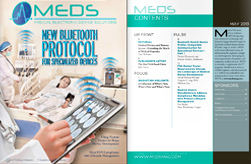I recently accompanied my wife to a doctor appointment after which I was chatting with the doctor about some of the advances we were seeing in medical electronics. One cannot always expect a working physician to be up on the latest developments even in equipment that is currently on the market, let alone the sort of advanced technologies that are being discussed in publications like MEDS.
So I was telling him about some of the device interfaces and imaging technologies that are start- ing to link medical instruments with commonly available consumer devices like smartphones and tablets. He calmly pulled out his iPhone, punched in something on the screen to a series of beeps, passed it up and down in front of my wife’s body, and to my amazement showed me a set of graphs and images on the phone’s screen.
When he saw that I was suitably impressed, he confessed that it was a toy Star Trek tricorder app that he had downloaded. But the lesson I take from that little incident is that for a brief moment there, he had me believing it. I am reminded that the very idea that we could have powerful, hand- held medical devices actually came from a pair of stainless steel salt and pepper shakers that were used to portray a diagnostic device in the early episodes of that TV show in the mid-1960s. Now we simply accept and expect such technology. And we expect to see it presented graphically.
The old saying that a picture is worth a thousand words is being turned around to go something like, “Ten megabytes is only useful as a picture.” By that I mean that we are experiencing a trend where even small sensors and devices, many of which may be wearable, present huge amounts of data that can best be presented in graphical form or as images for diagnostic comprehension.
Fortunately we are being aided by a generation of very small, low-power processors that in- corporate sophisticated graphics processing on chip. It is a truism that the highest-end graphics were developed for the gaming industry and only such volumes made them affordable for high-end military applications. By the same token, the proliferation of such consumer devices as smartphones and tablets has spurred the development of processors like Intel’s Atom family, the very low-power and high-performance variations in the ARM arena. The resulting volumes have made such devices affordable, and they can now be used for the much lower-volume world of medical electronics.
With the technology and its proliferation has come the level of expectation. Medical person- nel, like any other consumers, expect at least the same level of performance that they know from their phones and tablets to be available on the devices they use in their profession. Now they even expect to be able to use those same phones and tablets in their work. How this will all play out with regulatory issues appears to still be an open question, but the trend is happening and it will have to be dealt with as well.
It is not only a matter of expectations; it is also a matter of necessity. Our devices are producing vast amounts of data that is vital to healthcare and life-saving procedures. We have the technical capability to process and present it in useful form for medical professionals. We must do so in a safe, reliable and certified manner.

